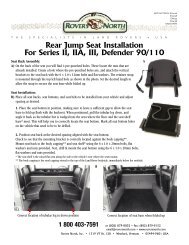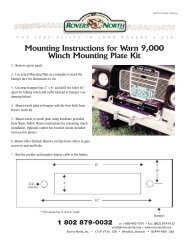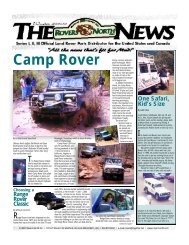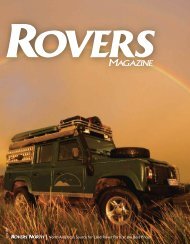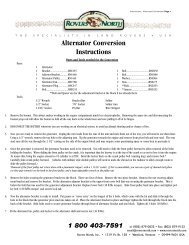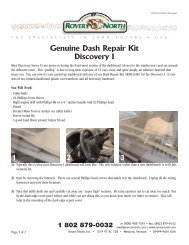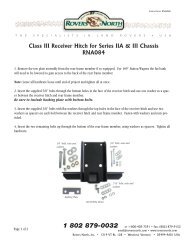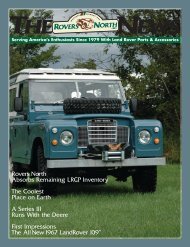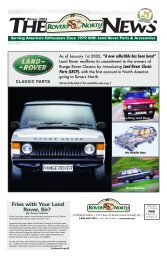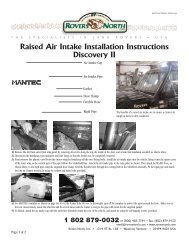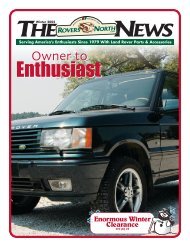You also want an ePaper? Increase the reach of your titles
YUMPU automatically turns print PDFs into web optimized ePapers that Google loves.
I’ve done something that I never thought I’d do. I recently purchased<br />
an Alpine White 1993 Range Rover Classic short wheelbase. How<br />
exciting, until you hear what I paid for it. It’s an $1,100 Range Rover<br />
Classic. “I thought those were expensive, Mike.” A 175,000-mile<br />
Range Rover Classic. “That’s no spring chicken, Mike.” A Range<br />
Rover Classic that’s spent it’s entire tour of duty in the northern<br />
reaches of Vermont. “Good from far, but far from good, Mike.” With<br />
its leather seats and walnut dash, it still presents proudly enough<br />
to take a date out to a respectable restaurant. For years, I’ve<br />
been interested in Series Rovers; vehicles that are somewhat<br />
straightforward to repair with simple hand tools, don’t have to be<br />
plugged in to a computer to be diagnosed, don’t depreciate faster<br />
than a concert Steinway falling from a skyscraper.<br />
Speaking of which, Range Rover Classics are certainly attainable<br />
these days, but you should scrutinize over each example you look at<br />
because a so-called value may end up costing you down the road. Are<br />
Range Rover Classics a better value now than ever? In 1993, mine<br />
had an MSRP of about $44,500 when it rolled off its showroom floor<br />
(literally, it was the display model). At the time of registration, the<br />
local Department of Motor<br />
Vehicles taxed me based on<br />
its book value, roughly<br />
$3,500. (remember to<br />
watch out for the falling<br />
pianos...) How on earth<br />
did these cars depreciate<br />
so much?<br />
Let’s take a look at<br />
what it takes to keep one<br />
of these discreet status<br />
indicators on the road and<br />
in service. According to my<br />
rudimentary calculations,<br />
after commuting in it<br />
everyday for about a month, it gets a magnificent 12.5 mpg. A Range<br />
Rover Classic will never be mistaken for a Prius. Thankful, for the<br />
planet we live on, I’ve been militant about my recycling chores lately.<br />
The Range Rover’s so-called fuel economy is a “value” in a distorted<br />
way. I like to think about it like this: it has twice the number of<br />
cylinders than my Series and multitudes more horsepower and speed.<br />
The Range Rover cruises effortlessly at 70 mph, whereas my 109”<br />
once saw a record speed of 62 mph on a steep downhill, a<br />
frightening experience altogether. The Range Rover is all-wheel-drive<br />
all the time, whereas the Series is in rear-wheel-drive during most of<br />
its travels. What are some of the more expensive parts to replace? An<br />
ABS pump retails at about $1,200. What about the ABS valve block,<br />
which retails at around $1,500? (I hope that doesn’t decide to stop<br />
functioning, especially since this Classic weighs in at 4,401 lbs.!) The<br />
viscous unit in the Borg Warner transfer case retails at about $1,600,<br />
not counting labour and other items that should probably be replaced<br />
at the same time - like the chain, gears and seals. At which point, it<br />
typically pays to replace the entire transfer box instead of fixing what’s<br />
broken. Corrosion is a constant battle in New England, especially<br />
when owning a Range Rover Classic. Perhaps 1993 is the best model<br />
year for the short wheelbase, as it has the benefits of ABS and ETC<br />
without the troublesome aging EAS. I’m trying to come up with a<br />
figure on a repair that would potentially send this car to an early<br />
grave. When will we reach the point of diminishing returns? How<br />
much do I love this Classic?<br />
Immeasurably. So, what’s it all about? What does this Range<br />
Rover bring to my life other than high fuel consumption and the<br />
dreaded question of “what if?” It’s like no other car I’ve driven or<br />
owned-and I’ve owned quite an embarrassingly high number for a<br />
man of my age. What I like the most about driving it is the way it<br />
makes me feel while driving it. When I drive my Range Rover, I feel<br />
like entitled royalty. It has that certain “je na sais quoi” of making its<br />
driver feel superior to other motorists surrounding him or her. While<br />
speaking to some fellow Classic enthusiasts the other night, we all<br />
agreed, that until you drive one on a regular basis, you really can’t<br />
grasp the aura this car beholds. I’ve heard the following: “All Range<br />
Rovers are cars, but not all cars are Range Rovers.” Narcissistically, I<br />
admire my reflection while driving my Range Rover past those shiny<br />
glass-faced contemporary<br />
office buildings in town.<br />
“Make way for the king of<br />
‘Vermontistan’ in his 1993<br />
Range Rover Classic!”<br />
Enough about my<br />
overly-inflated ego while<br />
driving the Range Rover; it’s<br />
also great for loading up<br />
with friends and heading<br />
out to dinner in style.<br />
This late Range Rover<br />
Classic just might be my<br />
favorite Land Rover.<br />
From its formidable<br />
driving height, I feel like I’m towering over all the other motorists on<br />
an imperial level. Like riding in a palanquin on the back of a<br />
pachyderm, I feel safe. All nonsequitors aside, the Classic’s timeless<br />
design looks “just right;” think of it as Goldylocks. The other night,<br />
I parked it in front of my Burlington condo and stood admiring it for<br />
almost five minutes. My neighbors must consider me mad. The<br />
Classic looks smart, and its exterior styling remained largely<br />
unchanged from its debut in 1970 till the end of its production in<br />
1995! There’s no mistaking my Range Rover for any other SUV<br />
resembling a melted cough drop, in any parking lot.<br />
It is chock-full-of-amenities. I routinely appreciate it’s factory<br />
fitted 120-watt a/d/s stereo with 6-disc CD changer (and<br />
weatherband), walnut dash, heated windscreen, glass sunroof,<br />
puddle lamps in the bottoms of the doors, ABS, ETC, power windows<br />
(the three that work), power locks, and leather heated power seats<br />
(more on that later). One of my favorite luxuries is the auto-dimming<br />
rearview mirror; it perfectly cuts the glare from those bothersome<br />
HID headlamps. Its uprated suspension was genuinely put to the test<br />
the other morning as I swerved to avoid a motorist even less awake<br />
31



